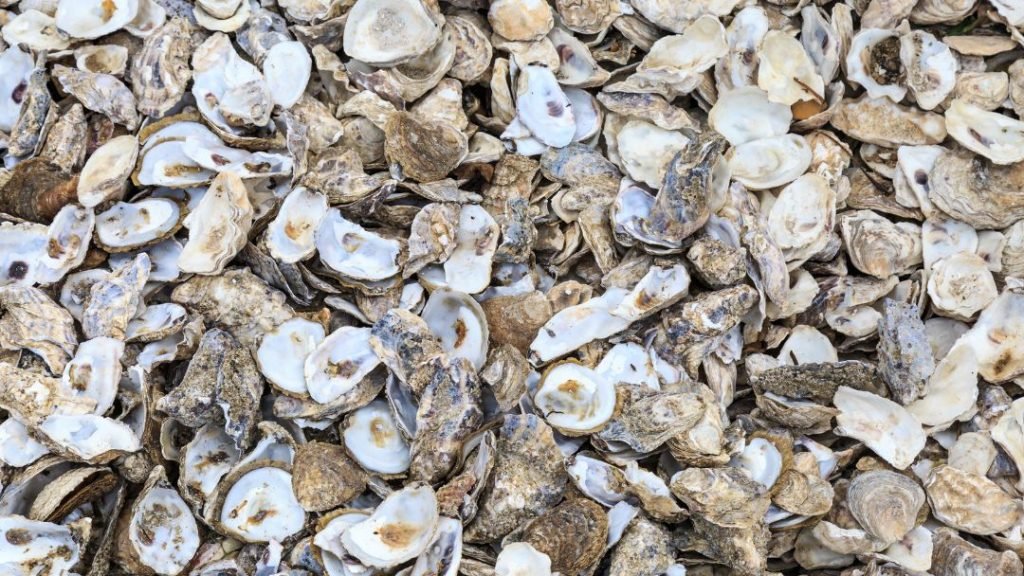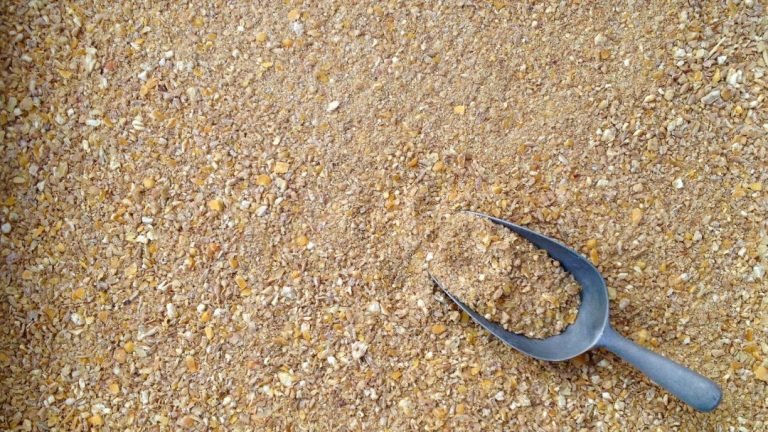Do you know more than 70% of chicken owners provide oyster shells to their chickens? Chicken keepers feed oyster shells to laying hens once they start laying eggs. Some start feeding them a few days before female chickens begin laying eggs.
Why feed chickens oyster shells? It provides enough calcium and helps to lay chickens lay eggs with thicker and stronger shells. Oyster shells also improve blood clotting, ensure muscle contraction, and provide a smooth transmission of nerve impulses.
Why Feed Chickens Oyster Shells?
The primary reason for feeding oyster shells to laying hens is to ensure they get enough calcium in their diet.
Oyster shells contain around more than 95% calcium carbonate. It makes their eggshells stronger. After all, calcium carbonate, or CaCO3, is the primary component of eggshells.
Female chooks will lay fresh eggs that will be free from bacteria. Oyster shells are essential to feed during spring and summer if they are free-ranging more.
Besides, oyster shells improve the blood clotting time to prevent blood loss following vascular injury.
In addition, it ensures muscle contraction by maintaining a proper integrated action among joints, bones, and skeletal muscles.
Regularly eating oyster shells will provide a smooth transmission of nerve impulses by carrying along nerve fibers and conveying signals to the spinal cord and brain.

What Are The Ingredients Of Oyster Shells?
Oyster shells are hard exoskeleton mollusks that belong to the group Ostreoidea.
These shells primarily contain 95% to 96% of calcium carbonate or CaCO3.
Besides these, it has a small number of minerals, such as magnesium, iron, and zinc.
Magnesium can play a crucial role in the rapid growth of egg production. It also improves the overall egg size and shell weight and preserves the quality of the eggshell in laying hens
Its small amount of iron boosts antioxidant activity and immunity and ensures the proper transportation and storage of oxygen
Besides, laying hens will be benefitted from the small proportion of zinc. It plays a crucial role in manipulating the female bird’s reproductive system.
When Don’t Chickens Need Oyster Shells?
It is not always mandatory to feed oyster shells to chickens.
You don’t need to serve these shells for the following purposes.
01. Baby Chicks And Non-Laying Hens
You don’t need to serve oyster shells, baby chicks, and non-laying hens, as they don’t lay eggs.
Besides, it might cause excessive calcium intake for them and reduce their growth and feed efficiency.
Their kidneys and liver may get affected, resulting in extra uric acid in their kidneys, causing blockages. So, for baby chicks go for the starter medicated chicken feed for the best result.
02. Certain Breeds
Are you raising only bantam chickens? If so, you don’t need to feed oyster shells.
These small-sized chickens lay small eggs with thinner shells.
Their eggs are not prone to break like larger or heavy breeds.
03. Free-range
Do you always keep your chooks in a free-range area? If so, it is not mandatory to feed oyster shells.
Free-range chickens usually eat various types of natural food, such as insects, greens, and small bones. Some may consume natural grit, such as rocks and pebbles.
All these food contains a higher amount of calcium. Chickens don’t need additional supplementation if they get enough calcium naturally.
04. Proper Diet
Do you feed a balanced diet to your feathered friends? Does it contain sufficient amounts of calcium?
Many chicken keepers feed layer feed or other similar options.
An adult laying hen needs only 4 to 5 grams of calcium daily. But you can feed up to 3.5% calcium level for better egg weight and eggshell quality.
This high-quality food contains a decent level of calcium to cover the requirements.
When Is Feeding Chickens Oyster Shells Necessary?
Are you getting soft or thin eggshells from your laying hens? If so, you want to feed oyster shells.
Thin-shelled eggs are more prone to breakage during laying or handling. It can also cause reproductive issues, such as egg binding or prolapse.
Also, soft-shelled eggs may not be suitable for incubation. This reduces the chances of successful hatching and impacting the growth of your flock.
Simply put, if laying hens are not getting enough calcium from their regular feed, you must feed them oyster shells.
How To Feed Chickens Oyster Shells?
Some chicken keepers prefer mixing oyster shells with regular feed. It may look palatable. But, your laying hens may overeat oyster shells.
Too much intake of calcium can lead to the formation of urinary stones in chickens and the development of kidney damage.
Instead, you should serve the oyster shells in a separate small container or pot. It should be a free choice, so hens can eat whenever they want.
You can warm them up for a few minutes as an extra precaution to kill any bacteria that may be present in the oyster shells.
Allow the shells to cool before offering them to your chickens. Avoid adding it to any food or water as it compromises overall nutrition.
When To Feed Chickens Oyster Shells?
Hens start laying eggs when they are 20 to 21 weeks of age. Feeding enough oyster shells is necessary before they begin laying eggs is essential.
It is a good rule of thumb to feed chickens oyster shells when female chickens become 18 weeks old.
You should not delay feeding them. Otherwise, laying hens will lay eggs with soft or thin eggshells.
But avoid serving oyster shells to young female chickens. They may consume an excessive amount of calcium, which can harm and affect their overall health.
What Are The Alternatives Of Oyster Shells?
Oyster shells might not be available in your area. Or, your poultry veterinarian might not be recommended to feed them.
Here are some common substitutes for oyster shells.
01. Crushed Eggshells

One of the best alternative sources of oyster shells is crushed eggshells, which contain 95% to 97% of calcium carbonate.
It is a source of extra calcium to strengthen eggshells and helps to lay hens lay larger eggs.
Instead of baking the eggshells, break them up into tiny pieces. Make sure it doesn’t contain any larger pieces.
Keep them in a dehydrator for one to two hours to make them harder. Add them into a mixer and form powder from the eggshells.
Before serving the crushed eggshells, make sure to put them in your oven for 10 minutes to crumble easily.
02. Limestone

Another excellent substitute for oyster shells is limestone. Chicken keepers can feed limestone in a mashed, crumbled, or pelleted form.
This fine material is crushed from limestone rocks. It contains 36% to 38% of calcium content. They have 42-44% magnesite to improve their breast quality and Redox Status.
However, high-quality limestone may have around 98% to 99% calcium carbonate and 1% to 3% impurities.
Limestone doesn’t just improve the eggshells’ quality of laying hens. It also increases the overall skeleton strength of the chooks.
Chicken owners must feed 10% of limestone to avoid calcium deficiency if they only rely on this for calcium supplementation.
03. Dolomite

Dolomite works as an essential calcium supplement for laying eggs.
It usually contains 60% calcium carbonate and 40% magnesium carbonate with smaller amounts of several other minerals.
Dolomite can improve skeletal growth and eggshell quality. It also works excellent for bone formation.
The magnesium in dolomite also helps with the absorption of calcium and the formation of eggshells.
It can also aid laying hens in reducing stress, which can be beneficial for their health and well-being.
How To Prepare Oyster Shells At Home?
Apart from commercially buying crushed oyster shells, you can prepare them at home.
All you need is to follow some basic steps to make them within a jiffy.
Step 01: Collect The Oyster Shells
First, collect the oyster shells you want to feed your chickens.
You can obtain these from grocery stores, seafood restaurants, fishermen, or seafood suppliers.
Make sure the shells are clean and free from any dirt and debris.
Step 02: Clean The Shells
Rinse the shells thoroughly with water to remove any dirt or debris.
You can also soak them in water for a few hours to loosen any remaining dirt substances.
If necessary, gently scrub them using a scrubbing brush for a few minutes.
Step 03: Dry The Shells
Spread the shells out on a baking sheet or tray and let them air-dry completely.
Alternatively, you can also dry them in the oven at a low temperature (around 200°F) for about an hour until completely dry.
Make sure to preheat the oven to 250 °F (121 °C) for 10 minutes before adding the oyster shells.
Baking oyster shells will eliminate any mold or bacteria lingering on the shells. It will be a safer option for laying chickens.
Step 04: Crack The Shells
Once the shells are dry, you can crush them. Dry shells are easy to crack.
Put all the dry oyster shells into an old sack, pillowcase, or feed bag. Close the bag to avoid shells frying while cracking it
Now, use a rolling pin, or a hammer, to make them into smaller pieces.
You want the pieces to be small enough for the chickens to consume easily.
Step 05: Grind The Shells
The final task is grinding the tiny pieces of oyster shells.
You can use a food processor or blender to grind and make them powder.
Keep grinding it until all pieces of shells turn into powder.
Make sure no large pieces are left in it. Otherwise, laying hens will struggle to digest them.
Step 06: Offer The Shells To Your Chickens
After grinding the shells properly, bake them in your oven for 10 minutes to crumble easily.
Serve the crushed oyster shells separately as a free choice. Laying hens can consume them as needed.
Monitor their intake habit. Make sure to refill the container when it becomes empty.
Tips For Feeding Chickens Oyster Shells
The followings are some pro tips for feeding oyster shells to laying hens.
01. Don’t Mix Oyster Shells With Regular Feed
Mixing oyster shells with regular feed can result in uneven consumption.
Some hens may consume too much or too little calcium compared to others.
It is better to provide oyster shells separately as a free choice.
02. Store Oyster Shells Properly
Store the oyster shells in a dry, cool place, away from direct sunlight and moisture
You can air-dry them or use a low-temperature oven to speed up the drying process.
Keep oyster shells in airtight containers or bags, such as mason jars or plastic bags with airtight seals. It will prevent moisture and humidity from getting in.
03. Don’t Serve Poor-quality Oyster Shells
If you have bought a huge amount of oyster shells at a time, some remaining portions may not be ideal for feeding.
Regularly check the oyster shells for signs of mold, bad odors, or discoloration.
If you notice any of these signs, discard the shells and replace them with fresh ones.
Wrapping UP
Are you still wondering why feed chickens oyster shells? Feeding laying hens a diet supplemented with oyster shells significantly increases eggshell thickness and strength.
We have already outlined how to feed oyster shells. Also, this article covered how to prepare oyster shells at home. Make sure to collect high-quality and pure oyster shells.
If you buy a large number of oyster shells, store them securely in a container. It should stay fresh as long as you serve it to your laying hens.







